
No two people, let alone architects, perceive even the most frequented cities in the same way. How do designers experience their cities as locals?
As the largest metropolis in mainland China and the world, Shanghai continues to boom at a dizzying pace. Among all the sights and sounds within the city, Shanghai is bustling with people (about 24 million, that is), tantalizing food, and of course a rich mix of architecture -- from the historic ancient structures to the futuristic Lujiazui skyline. How can a visitor not feel overwhelmed?
Archinect reached out to locally based Four O Nine co-founder Andrei Zerebecky to share what places around town he would recommend to the architecturally inclined traveler. Read on to check out his suggestions, along with some historic factoids.
1. Let Sleeping Dragons Lie - Nine Dragon Pillar

One ubiquitous thing about getting around in Shanghai is the ‘gaojia’ or elevated roadways. At night, the underbelly of these massive infrastructural ribbons are illuminated with a deep indigo LED light. For me, the most memorable sight is at the intersections of Yan’an Road and Chengdu Road, where the stacked roadbeds seem to overlap eachother endlessly and are supported by a single massive ornamented central column. This Nine Dragon Pillar is wrapped in metallic bas-relief of nine dragons, inspired – so the story goes – by the discovery of a sleeping dragon lying directly below the construction site, which delayed piling.
Nine Dragon Pillar Artist: Zhao Zhirong
Address: Intersection of Yan’an Elevated Road + Chengdu Road
Completion: 1999

This beautiful new museum on Shanghai’s developing West Bund district is built on an existing coal port from the 1950s. Architects Atelier Deshaus designed the new museum structure using a series of interlocking cantilevered concrete vaults that spring from the existing underground parking structure. The pure concrete forms overlap and slip past each other, framing entrances, forming exhibition halls, and giving way to skylights and windows. Natural light pours over the clean and simple concrete vaults of the exhibitions spaces, which have all the necessary electrical and mechanical equipment cleverly integrated within. The same concrete vaults form an exterior courtyard over an existing 110m long coal-hopper structure, forming the central spine of the new museum and demarking the building’s main entrance.
Address: Lane 3398, Longteng Avenue, Xuhui District, Shanghai.
Architects: Atelier Deshaus
Completed: 2014
Opening Hours: 10:00am-6:00pm, Tuesday-Sunday, Monday closed. Last admission is at 5:00pm.
3. High Rise Pudong - Lujiazui skyline:

Architects will surely appreciate the cluster of skyscrapers in Pudong (and someone else will surely recommend them to you). Hopefully, you can find a clear day and get up to the observation deck of the Shanghai World Financial Center or ‘Bottle Opener’ as it is affectionately called. The view over Shanghai’s sprawl of highrises is definitely worth seeing. But while you are finding your way there, I recommend stopping to admire a couple architectural follies that you may not see anywhere else but China.
First, of course, is the 21-year-old Shanghai Oriental Pearl TV Tower – the Jetsons-era looking iridescent pink and concrete communications tower. This, too, is a popular tourist destination. However, very near this tower is a lesser-known sight – a 20+ storey masonry building that appears to be constructed entirely of classical columns; the home of PingAn Insurance [pictured below]. Stop, take a photo, awe in its grotesque appropriation of the classical order and carry on to the SWFC (Hyatt Lounge) or IFC (Ritz Carlton terrace) to get a great overview of the city.

Pudong Highlights:
Shanghai World Financial Center
100 Century Ave, Pudong District
Architects: KPF
Completed: 2008
Jin Mao Tower
88 Century Ave, Pudong District
Architects: SOM
Completed: 1999
Shanghai Tower
Lujiazhi, Pudong District (hard to miss)
Architects: Gensler
Completion: 2015
Oriental Pearl TV Tower:
Lujiazui Ring Road, Pudong District
Architects: Jia Huan Cheng, Zhang Xiulin, Lin Benlin
Completed: 1994
PingAn Insurance Building
1333 Lujiazui Ring Road, Pudong District
Architects: not listed
Completed: 2010
4. The Waterhouse at South Bund

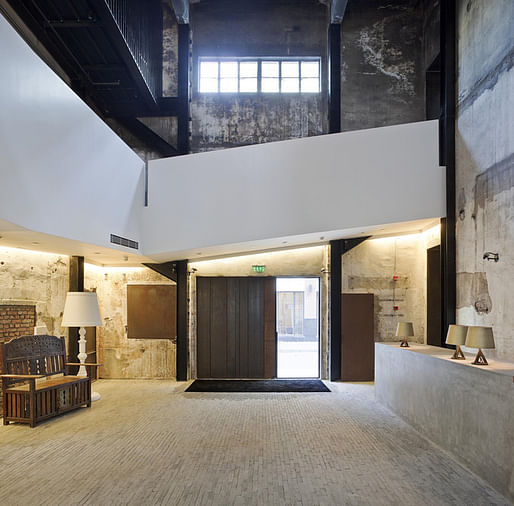
This former Japanese army headquarters was originally built in the 1930s. It has since been renovated with a cor-ten steel rooftop extension and converted into a 19 room boutique hotel. The existing masonry façade has been kept raw and unfinished. Select windows and doors on the existing façade have been blocked off with cor-ten panels to make way for the new interior – adding to the curious and derelict ouvre of the façade. You enter through a cor-ten and wood door into the main hotel lobby; a double height space with existing concrete and stucco walls left largely exposed and in disrepair. This exposure of existing structure balanced against sleeker new interior volumes is a common theme in the work of architects Neri & Hu. This project is a great example of that juxtaposition and has a great rooftop with amazing views over the HuangPu river.
Address: Maojiayuan Road No.1-3, Zhongshang Road South, Huangpu District
Architects: Neri & Hu
Completed: 2010
5. Zhong Plaza

Off of Shanghai’s luxury shopping strip, Nanjing Road, find Taixing Road and follow it south. The street becomes a very sketchy laneway filled with delapitated bicycles and garbage bins and appears to become a local residential neighborhood. Continue on through a vehicular gate to find Zhong Plaza, a hidden gem of gentrification. This courtyard features a number of new restaurants and bars frequented by a mix of Chinese and Western patrons. Once in the courtyard, walk through the florist shop to find a staircase at the back leading you to all my favorite spots; Tomatito has great Spanish tapas, Logan’s Punch next door has a quirky interior reminiscent of Shanghai’s old laneways, and el Ocho on the top floor has a grand pitched roof space with all the whiskey and bourbon one could ask for.
Address: 99 Taixing Road near West Nanjing Road
6. Former French Concession + Wukang Lu
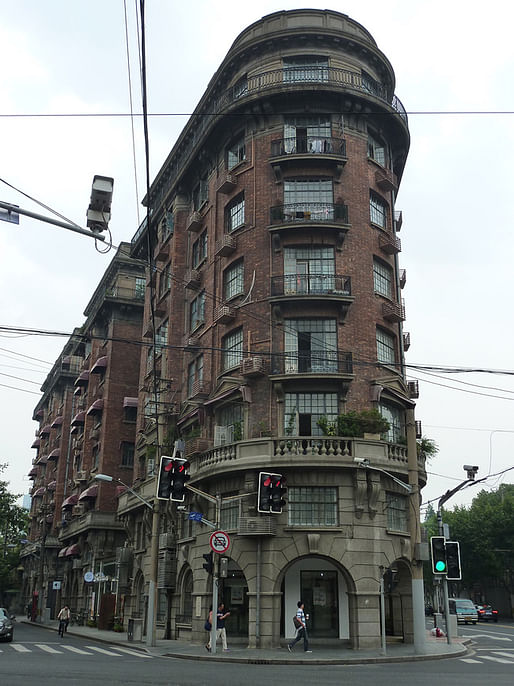
Still one of my favorite parts of Shanghai, the Former French Concession area retains a unique low-rise character within urban Shanghai. The area saw a lot of development in the early 1900s as a premiere residential neighborhood. Hence, a lot of French Colonial and Art Deco style buildings remain along its shaded tree-lined streets.
Start at the intersection of Huaihai Middle Road and Wukang Road to find the famed Normandy Apartment Building, a wedge-shaped French Renaissance-styled building by architect Laszlo Hudec. One of the neighborhood’s first luxury residences to feature balconies, the building later became known as ‘The Diving Board’ during the Cultural Revolution when many intellectuals and enemies of the state leapt to their deaths to avoid persecution. From the intersection, walk along Wukang Lu – a sleepy tree-lined street featuring the former residences of numerous notable Chinese and Western politicians, writers and ambassadors (some of which welcome guests inside).
At the intersection of Wukang Road and Taian Road you will come upon a commercial development called Ferguson Lane, referencing the original name of Wukang Road; Rue Ferguson. Many restaurants, wine shops and a couple small galleries can be found within the courtyard. Finish off with a meticulously crafted cocktail at nearby Mardi Gras, a Japanese-run bar on the 2nd floor of an old French Colonial lanehouse (372 Xingguo Road near Taian Road).
Normandy Apartment Building
Address: 1858 Huahai Middle Road near Wukang Road.
Architect: Laszlo Hudec
Completed: 1924
7. 10 Corso Como, near the Jing’An Temple
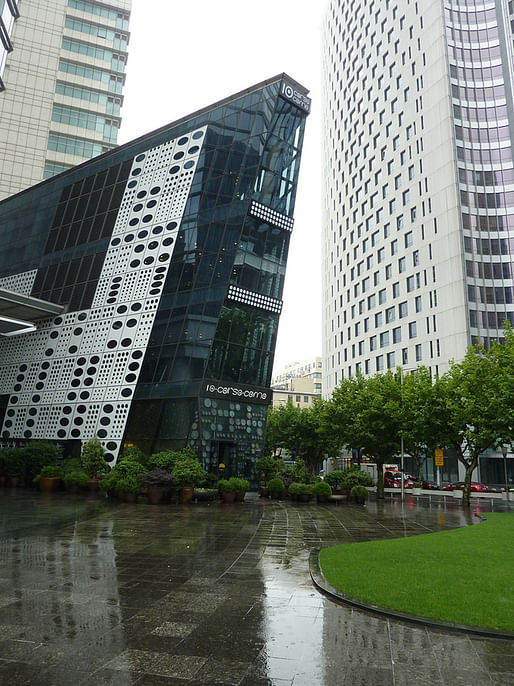
Across the street from the famous Jing’An Temple, a curious glass wedge seems to sprout from between the commercial highrises surrounding it. 10 Corso Como is the China flagship of this concept/lifestyle brand from Italy that showcases a fusion of design, fashion and art. Artist Kris Ruhs designed the building containing a ground floor retail shop and café, gallery space, a restaurant and lounge on the top floor. Aside from the bold form, the building and its interior carries a common circular theme throughout, forming façade panels, screens and various interior decorative devices like the bar, found on the top floor. Best seat in the place is in the lounge at the very tip of the wedge where you can overlook the elaborate gold rooftops of Jing’An Temple and admire its juxtaposition with the urban highrises that surround it.
Address: 1717 Nanjing Xi Lu, near Huashan Lu
Architecture: Artist Kris Ruhs
Completed: 2013
8. Oh Canada! - Ports 1961
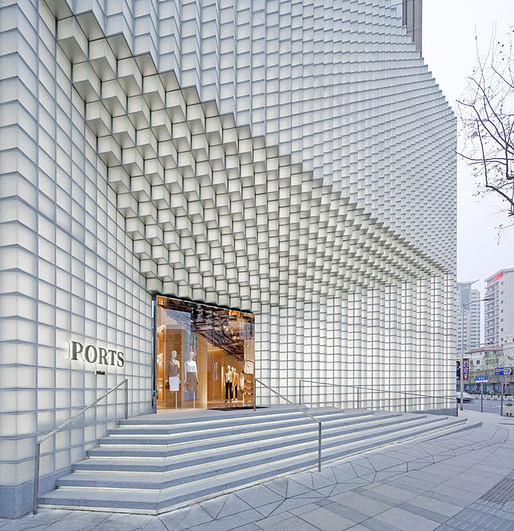
This new flagship for Canadian-born fashion house Ports 1961 has just recently been added to the busy Nanjing West Road shopping strip. Occupying a corner lot, the architects Uufie (also from Canada) proposed a pixilated 3D glass block façade meant to emulate a floating iceberg. The façade wraps around the corner and incorporates a gradually set-back entrance, display windows and several LED screens looping advertisements and runway shows to the bustling street. During the day, the gradually sculpted façade creates sharp shadow lines and defines the main boutique entrance. At night the glass blocks composing the façade glow from within like a lantern. The façade gives way to a subdued but gorgeous interior by renowned Canadian interior design firm Yabu Pushelberg. Worth a stop if you find yourself in the neighborhood.
Address: Nanjing West Road at Changde Road, Jing’An District
Architect: Uufie
Interior Design: Yabu Pushelberg
Completed: 2015
9. Shanghai's 1933 slaughterhouse


One of Shanghai’s numerous Art Deco buildings, this former slaughterhouse is a rare find. Said to be the last remaining building of its kind, this cast concrete utilitarian structure was built in 1933 by British architects and Chinese developers. From the street, the building is adorned with Art Deco screens and columns. Inside, the structure is organized around a large central hall housing the abattoir’s workshop. This hall is connected to the perimeter building by a series of 26 interlocking concrete bridges and ramps, used to convey cattle to their slaughtering stations. The complex network of ramps cross over one another creating a dramatic internal courtyard volume that adds to the maze-like interior experience.
The building had been long abandoned until an extensive restoration effort brought it back to its original condition in 2008. 1933 Shanghai now serves as a commercial hub for creative industries with some retail boutiques and restaurants including (of course) a new steakhouse.
Address: No. 10 Shajing Road, Hongkou District
Completed: 1933, restored 2008
10. Shanghai Exhibition Center
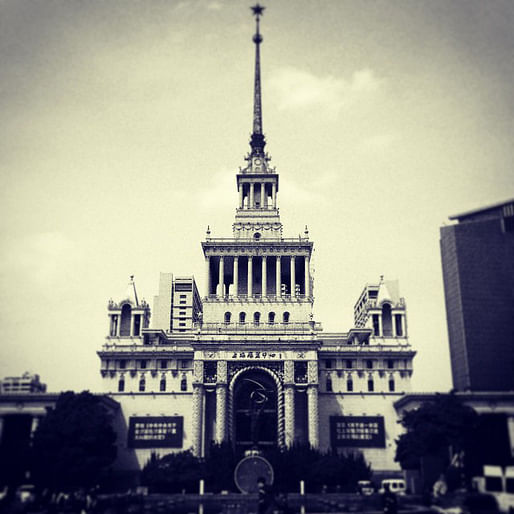

This palatial neoclassical exhibition compound was constructed in 1955 to commemorate 50 years of alliance between China and the Soviet Union. The sprawling wings of this symmetrical building compound encircle several internal courtyards with the largest located at the main gate at 1000 Yan’an Road and featuring a large pool with fountains
The main feature of the building is its 100m tall spire, modeled after the Admiralty Building in St. Petersburg. Inside, the various halls feature elaborately ornamented domed roofs and a striking 30m wide vaulted Central Hall.
Throughout its history, the building has served as Shanghai’s first exhibition center, housed historical conferences and served as the de facto building of the Shanghai Municipal Government. Today it is used for various conferences and exhibitions. Access to the interior exhibition halls is restricted to events but a new men’s clothing boutique has just opened a showroom within the compound walls at the northernmost point of the West Hall. Access onto the grounds should be easy from the Nanjing West Road side.
Address: 1000 Yan’an Road, Jing’An District
Completed: 1955, restored 2011
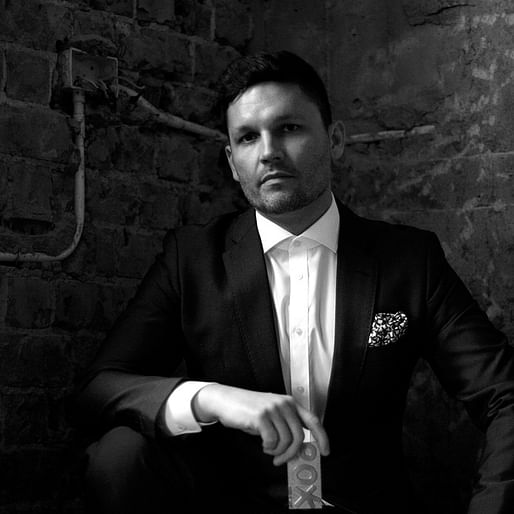
Andrei Zerebecky
Andrei Zerebecky was born in Canada and received his Master of Architecture degree from the University of Toronto. In 2007 he moved to Asia to work as an architect in Shanghai, Dubai, Beijing and Uzbekistan. In 2009 he was relocated to Vietnam to establish and run a branch office of B+H Architects. In 2011, Andrei co-founded Four O Nine, a studio of Architecture and Design with partner Lukasz Kos. Soon after they had completed their first built projects in Asia, Four O Nine’s work began receiving substantial international attention. Their work has since been recognized in numerous international design publications, television and radio programs and received a handful of design awards. Andrei currently resides in Shanghai and manages the Asia office of Four O Nine.
Check out Archinect's previous travel guides here.
3 Comments
One of my favorite cities!
I love that the PingAn Insurance "column building" made the list :D
^me too!
The design architect was nikken sekkei
I've been in it - the atrium is immense and very impressive, in a modern style totally unsuited to the exterior.
Block this user
Are you sure you want to block this user and hide all related comments throughout the site?
Archinect
This is your first comment on Archinect. Your comment will be visible once approved.